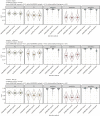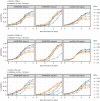Real-time monitoring of COVID-19 dynamics using automated trend fitting and anomaly detection
- PMID: 34053271
- PMCID: PMC8165581
- DOI: 10.1098/rstb.2020.0266
Real-time monitoring of COVID-19 dynamics using automated trend fitting and anomaly detection
Abstract
As several countries gradually release social distancing measures, rapid detection of new localized COVID-19 hotspots and subsequent intervention will be key to avoiding large-scale resurgence of transmission. We introduce ASMODEE (automatic selection of models and outlier detection for epidemics), a new tool for detecting sudden changes in COVID-19 incidence. Our approach relies on automatically selecting the best (fitting or predicting) model from a range of user-defined time series models, excluding the most recent data points, to characterize the main trend in an incidence. We then derive prediction intervals and classify data points outside this interval as outliers, which provides an objective criterion for identifying departures from previous trends. We also provide a method for selecting the optimal breakpoints, used to define how many recent data points are to be excluded from the trend fitting procedure. The analysis of simulated COVID-19 outbreaks suggests ASMODEE compares favourably with a state-of-art outbreak-detection algorithm while being simpler and more flexible. As such, our method could be of wider use for infectious disease surveillance. We illustrate ASMODEE using publicly available data of National Health Service (NHS) Pathways reporting potential COVID-19 cases in England at a fine spatial scale, showing that the method would have enabled the early detection of the flare-ups in Leicester and Blackburn with Darwen, two to three weeks before their respective lockdown. ASMODEE is implemented in the free R package trendbreaker. This article is part of the theme issue 'Modelling that shaped the early COVID-19 pandemic response in the UK'.
Keywords: ASMODEE; algorithm; machine learning; outbreak; surveillance; trendbreaker.
Figures





References
-
- Lai S, et al. . 2020. Effect of non-pharmaceutical interventions for containing the COVID-19 outbreak in China. medRxiv. (10.1101/2020.03.03.20029843) - DOI
-
- Courtemanche C, Garuccio J, Le A, Pinkston J, Yelowitz A. 2020. Strong social distancing measures in the United States reduced the COVID-19 growth rate: study evaluates the impact of social distancing measures on the growth rate of confirmed COVID-19 cases across the United States. Health Aff. 10, 1377. (10.4324/9781003141402-20) - DOI - PubMed
Publication types
MeSH terms
Grants and funding
LinkOut - more resources
Full Text Sources
Other Literature Sources
Medical
Research Materials

